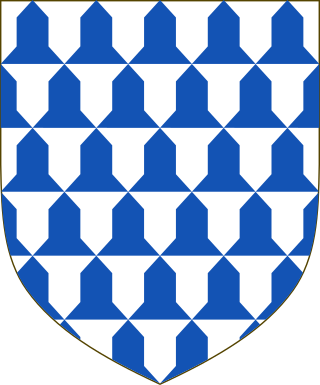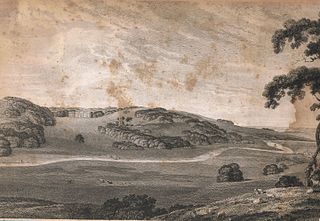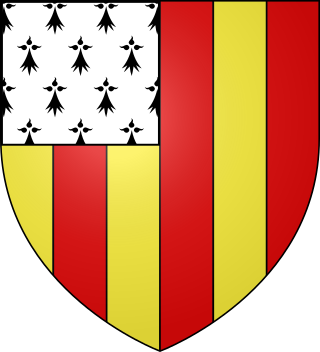
William Martin, 1st Baron Martin (died 1324), [2] Lord of Cemais and Barnstaple was an English noble. He fought in the wars in Wales, Gascony, Flanders and Scotland. He was a signatory of the Baron's Letter to Pope Boniface VIII in 1301.

William Martin, 1st Baron Martin (died 1324), [2] Lord of Cemais and Barnstaple was an English noble. He fought in the wars in Wales, Gascony, Flanders and Scotland. He was a signatory of the Baron's Letter to Pope Boniface VIII in 1301.
William was the eldest son of Nicholas Martin and Maud de Brain. [2] He served in Wales, Gascony, Flanders in 1297 and in Scotland.[ citation needed ] William took part in the battle of Falkirk on 22 July 1298. [1] He was a signatory of the Baron's Letter to Pope Boniface VIII in 1301. [1]
He died in 1324 and was succeeded by his second son William. His eldest son Edmund pre-deceased him. [2]
William married firstly Eleanor, the widow of John de Mohun, she was a daughter of Reginald FitzPiers and Joan de Vivonia.[ citation needed ]
They had the following children:
William married secondly Amicia, widow of Henry de Pomeroy, Baron of Berry Pomeroy, she was a daughter of Geoffrey de Camville.
The Martin line ceased to exist after the death of Edmund and William, Eleanor died without issue, and the titles revered to the heirs of Joan Martin. [4] [5]
William's eldest son inherited the family property and, via his marriage with Angharad, regained the lost territory of Kemes/Cemais. The family would continue to hold lands in both England and Wales until the extinction of the senior line in 1326. Cadet lines still flourish in England, Wales, Ireland and beyond.[ citation needed ]

William III de Ferrers, 5th Earl of Derby of Chartley Castle in Staffordshire, was an English nobleman and major landowner, unable through illness to take much part in national affairs. From his two marriages, he left numerous children who married into noble and royal families of England, France, Scotland and Wales.

John Neville, 3rd Baron Neville, was an English peer, naval commander, and soldier. His second wife was Elizabeth Latimer who was the 5th Baroness Latimer in her own right.

FitzMartin or Fitz Martin was the surname of a Norman family based in England and Wales between 1085 and 1342.
The Lords of Cemais were the ruling families, from the early 12th century of the Marcher Lordship of Kemes, and in later centuries of the barony of Cemais (Dyfed).

Robert FitzWalter, 1st Baron FitzWalter was an English landowner, soldier, administrator and politician.
John Hastings, 1st Baron Hastings, was an English landowner, soldier and administrator who was one of the Competitors for the Crown of Scotland in 1290 and signed and sealed the Barons' Letter of 1301. He was Lord of the Manor of Hunningham.
Joan de Geneville, 2nd Baroness Geneville, Countess of March, Baroness Mortimer, also known as Jeanne de Joinville, was the daughter of Sir Piers de Geneville and Joan of Lusignan. She inherited the estates of her grandparents, Geoffrey de Geneville, 1st Baron Geneville, and Maud de Lacy, Baroness Geneville. She was one of the wealthiest heiresses in the Welsh Marches and County Meath, Ireland. She was the wife of Roger Mortimer, 1st Earl of March, the de facto ruler of England from 1327 to 1330. She succeeded as suo jure 2nd Baroness Geneville on 21 October 1314 upon the death of her grandfather, Geoffrey de Geneville.

James Audley, 2nd Baron Audley of Heighley Castle, Staffordshire, was an English peer. He was the son and heir of Nicholas Audley, 1st Baron Audley (1289–1316) by his wife Joan Martin, who was the daughter of William Martin, feudal baron of Barnstaple, and Marcher Lord of Kemes. She was posthumously the eventual sole heiress of her brother William FitzMartin to Barnstaple and Kemes.

John de Beauchamp, 2nd Baron Beauchamp of Somerset was an English peer and was feudal baron of Hatch Beauchamp in Somerset.

From AD 1066, the feudal barony of Barnstaple was a large feudal barony with its caput at the town of Barnstaple in north Devon, England. It was one of eight feudal baronies in Devonshire which existed in the Middle Ages. In 1236 it comprised 56 knight's fees or individual member manors. The feudal service owed for half the barony in 1274 was the provision to the royal army of two knights or four sergeants for forty days per annum, later commuted to scutage.
William (Guillaume) de Falaise, was a Norman from Falaise, Duchy of Normandy, today in the Calvados department in the Lower Normandy region of north-western France. He became feudal baron of Stogursey in Somerset and also held manors in Devon.
The Manor of Combe Martin was a medieval manor estate in Combe Martin, Devon, England.

The feudal barony of Bampton was one of eight feudal baronies in Devonshire which existed during the mediaeval era, and had its caput at Bampton Castle within the manor of Bampton.

The historic manor of Tawstock was situated in North Devon, in the hundred of Fremington, 2 miles south of Barnstaple, England. According to Pole the feudal baron of Barnstaple Henry de Tracy made Tawstock his seat, apparently having abandoned Barnstaple Castle as the chief residence of the barony. Many of the historic lords of the manor are commemorated by monuments in St Peter's Church, the parish church of Tawstock which in the opinion of Pevsner contains "the best collection in the county apart from those in the cathedral", and in the opinion of Hoskins "contains the finest collection of monuments in Devon and one of the most notable in England".
Margaret II Audley was a co-heiress to the feudal barony of Barnstaple in Devon, England.

There have been four different baronies held by the Marmion family, two feudal baronies, one purported barony created by Simon de Montfort and one barony by writ.

John de Beauchamp, 1st Baron Beauchamp "de Somerset", was feudal baron of Hatch Beauchamp in Somerset. He fought in the wars in Scotland and was a signatory of the Baron's Letter to Pope Boniface VIII in 1301.

Ralph Basset, 2nd Baron Basset of Drayton was a 13th-14th century English nobleman who fought in both the Anglo-French War and in the First War of Scottish Independence.

The feudal barony of Stafford was a feudal barony the caput of which was at Stafford Castle in Staffordshire, England. The feudal barons were subsequently created Barons Stafford (1299) by writ, Earls of Stafford (1351) and Dukes of Buckingham (1444). After the execution of the 3rd Duke in 1521, and his posthumous attainder, the castle and manor of Stafford escheated to the crown, and all the peerage titles were forfeited. However the castle and manor of Stafford were recovered ten years later in 1531 by his eldest son Henry Stafford, 1st Baron Stafford (1501-1563), who was created a baron in 1547. His descendants, much reduced in wealth and prestige, retained possession of Stafford Castle and the widow of the 4th Baron was still seated there during the Civil War when shortly after 1643 it was destroyed by Parliamentarian forces. By the time of the 6th Baron Stafford (d.1640) the family had sunken into poverty and obscurity, and in 1639 he suffered the indignity of being requested by King Charles I to surrender his title on account of his "having no parte of the inheritance of the said Lord Stafford not any other landes or means whatsoever". On his death the following year, unmarried and without issue, the senior male line of the Stafford family was extinguished. However a vestige of the feudal barony may be deemed to have continued in the families of later owners of the manor of Stafford and site of the Castle, after the abolition of feudal tenure in 1661.

Baron Camville was a title created in the Peerage of England for Geoffrey de Camville II, of Clifton Campville in Staffordshire, who having been summoned to Parliament on 24 June 1295 and subsequently, by writs directed to Galfrido de Caunvilla, Caumvilla, Canvilla or Camvilla, was deemed thereby to have been created Baron Camville.